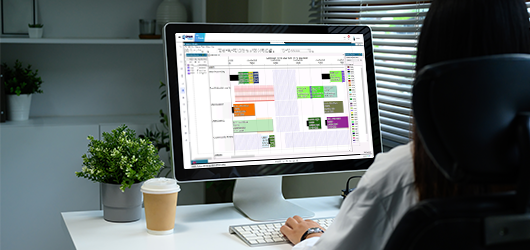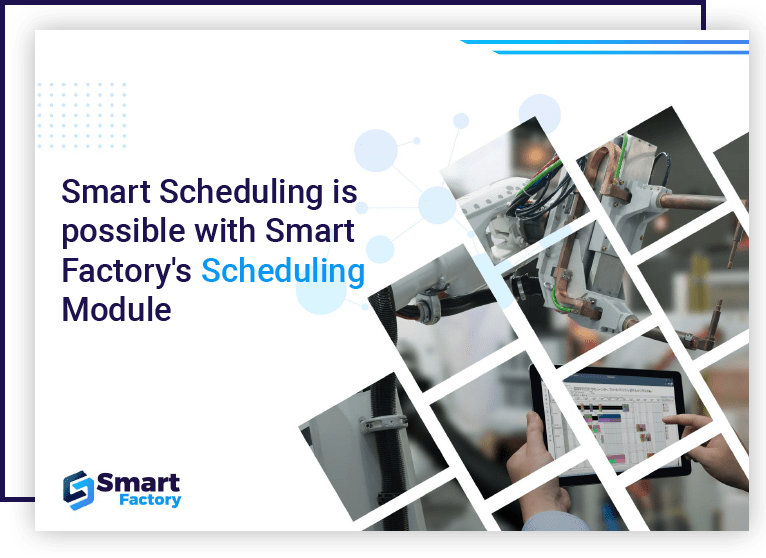How Does One Distinguish Between Planning and Scheduling?
To ensure future demand is met, an advanced planning system serves as a strategic decision support tool that integrates forecasts and long-term orders to target stock levels and capacity allocation. Planning periods may span days, weeks, months, or a combination of these timeframes. Planning can be conducted with finite or infinite capacity considerations. If the scheduling system is used in conjunction, the planning system will override the planned volume with the scheduled volume and send back specific production schedule information, allowing for recalculation of the master production schedule (MPS) based on the production schedule.
Advanced scheduling, a finite capacity tool utilizing a comprehensive plant model, generates a feasible timeline by considering various constraints and the actual availability of resources. While also applicable in services and logistics, it primarily serves manufacturers requiring scheduling of equipment, production lines, and resources. Typically, manufacturing orders with attached process routes outlining operational procedures needed for product creation serve as input. After applying scheduling rules, users can interact with the schedule and allocate orders to specific resources.
What is Production Planning for Manufacturing?
Planning for manufacturing involves strategically aligning your company’s objectives and devising a plan to achieve them. This entails recognizing the value your company provides to its clients. Interestingly, the foundational concept of lean manufacturing revolves around understanding this value proposition.
Let’s consider an example, suppose you are a car manufacturer known for producing vehicles with the best mileage in their class. Therefore, the initial step in the planning process is to clarify your company’s core concepts and the reasons why your clients choose your products—mileage, in this instance.

Continuing with our example, you might set goals to increase the output of your best-selling car by 10% and to raise overall revenue by 5% by the conclusion of the planning process. With the planning phase completed, the next step is to create the manufacturing schedule.
What is the Purpose of Production Planning?
Production planning and control is a crucial process that entails making strategic decisions on how to best allocate resources, schedule, and satisfy customer demand while also achieving organizational goals. It includes a thorough investigation of what goods, in what amounts, and at what times should be produced.

What is Production Scheduling in Manufacturing?
As the saying goes, “the devil is in the details.” Since daily operations rely heavily on scheduling, it can be quite challenging. The scheduling system you employ should be adaptable to changing conditions, robust enough to manage conflicting priorities, and dynamic in nature.
Building on the car manufacturing example, the scheduling process involves ironing out the specifics. This may include decisions on which facilities will ramp up production or receive upgrades. Additionally, your schedule should specify the location of each car’s production, right down to the specific machines to be used for each task.

How Does Production Scheduling Works?
Creating a thorough and complete schedule that specifies the precise sequence and timing of production activities is known as production scheduling. This process, taking resource availability, limitations, and dependencies into consideration, entails making crucial decisions about the start and end times of each activity or process.

A seamless production process, reduced costs, and increased productivity all depend on efficient manufacturing scheduling.

Importance of Production Planning and Scheduling and Planning
- Fulfilling Clients' Needs: Good manufacturing planning and scheduling prevent stockouts, shorten lead times, and enhance customer satisfaction by ensuring prompt delivery of goods in the necessary amounts.
- Best Use of Available Resources: Careful planning and scheduling enable businesses to deploy resources more effectively, minimizing downtime, cutting expenses, and increasing output. This leads to improved operational effectiveness and resource utilization.
- Budgetary Management: Precise demand prediction and effective scheduling prevent overproduction, lower the cost of keeping goods on hand, shorten setup times, eliminate bottlenecks, and maximize resource utilization—contributing to overall cost savings.
- Enhanced Productivity: Efficient planning optimizes production flow, reduces cycle times, and enhances overall efficiency, simplifying operations and eliminating waste.
- Informed Decisions: Well-defined plans make it easier to make well-informed decisions about capacity management, production priorities, and resource allocation, allowing for flexibility and timely output.
- Teamwork and Coordination: Planning and scheduling for manufacturing involve departmental cooperation, improved coordination and communication, synchronized production, fewer delays, and increased operational efficiency.
- The Ability to Grow and Scale: Well-crafted production plans and schedules lay the groundwork for managing rising demand, expanding operations, and adjusting to market conditions, making scalability and seizing growth opportunities more accessible.
- Constant Enhancement: To drive continual optimization and maintain a competitive edge, discovering areas for improvement through data analysis, schedule evaluation, and production performance monitoring is essential.
How APS Software Differentiates Between Planning and Scheduling?
APS software works as a solution tool for modern manufacturers in their search for production process optimization, specifically in the area of creating execution schedules, normally considered as production schedules. However, it is common that due to its application, problems may arise in understanding what it is and what it is not, and what its level of application is, which leads us to have to differentiate between planning and programming, which despite being interconnected concepts, are different, since:
- Planning: It focuses on the sequence or schedule of activities to be carried out in medium to long-term horizons, which implies that the alignment of said production plan is directed to commercial objectives and the forecast of future demand based on long terms.
- Scheduling: On the other hand, it determines (in a similar way to planning) the exact time and sequence of production activities, considering restrictions such as the supply of materials, the availability of resources and the production capacity of available resources (such as machines, personnel and tools) in a closer or shorter horizon, that is, in the short term, and without considering future demand.
Planning vs Scheduling for APS System application level
Although it may be evident or obvious, these small differences can be transcendental to understand how or what is needed for the approach or needs that a company may have, therefore, in order to understand how these concepts have, based on these basic points, differences in their application and operation, we ask you to see the following table that can give you greater detail on what are the points of difference between both concepts.
| Aspect |  Planning Planning |
 Scheduling Scheduling |
|---|---|---|
| Definition | High-level process of determining what needs to be produced, when, and in what quantities, based on demand forecasts and production capacity. | Detailed process of assigning specific resources (machines, workers) to tasks at precise times, creating a time-bound production sequence. |
| Time Horizon | Long to medium term (weeks, months, or even years). | Short term (hours, days, or weeks). |
| Goal | Align production with market demand, optimize inventory levels, and balance resource capacity. | Minimize production time, optimize machine utilization, and reduce lead times. |
| Input Data | Sales forecasts, customer orders, inventory levels, resource availability, BOMs (Bill of Materials). | Real-time machine status, operator availability, setup times, production rates. |
| Output | Master Production Schedule (MPS), material requirements, capacity plans. | Detailed production schedules, job sequences, and Gantt charts. |
| Flexibility | More flexible, easier to adjust with changing forecasts. | Less flexible once the schedule is live — changes can cause disruptions. |
| Granularity | Aggregated, focuses on product families or batches. | Detailed, down to individual work orders or operations. |
| Tools & Methods | MRP (Material Requirements Planning), Capacity Planning, Demand Forecasting. | Finite Capacity Scheduling, Sequencing Algorithms, Dispatching Rules. |
| Key Constraints | Resource capacities, material availability, production lead times. | Machine availability, setup/changeover times, worker shifts, maintenance windows. |
| Typical APS Modules | Demand Planning, Capacity Planning, Material Planning. | Job Scheduling, Sequence Optimization, Real-Time Rescheduling. |
Utilizing the Smart Factory MOM Solution for Production Scheduling
In summary, planning focuses on the bigger picture, while scheduling deals with the details. Planning outlines the tasks and sets the overall direction, whereas scheduling determines the strategies needed to achieve the objectives defined in the plan. Similarly, production planning involves long-term decisions and ensures that production operations align with customer demand and the company’s overall business strategy. In contrast, production scheduling focuses on short-term decisions aimed at maximizing productivity, minimizing costs, and maintaining a smooth production process.
How Does One Distinguish Between Planning and Scheduling?
To ensure future demand is met, an advanced planning system serves as a strategic decision support tool that integrates forecasts and long-term orders to target stock levels and capacity allocation. Planning periods may span days, weeks, months, or a combination of these timeframes. Planning can be conducted with finite or infinite capacity considerations. If the scheduling system is used in conjunction, the planning system will override the planned volume with the scheduled volume and send back specific production schedule information, allowing for recalculation of the master production schedule (MPS) based on the production schedule.
Advanced scheduling, a finite capacity tool utilizing a comprehensive plant model, generates a feasible timeline by considering various constraints and the actual availability of resources. While also applicable in services and logistics, it primarily serves manufacturers requiring scheduling of equipment, production lines, and resources. Typically, manufacturing orders with attached process routes outlining operational procedures needed for product creation serve as input. After applying scheduling rules, users can interact with the schedule and allocate orders to specific resources.
What is Production Planning for Manufacturing?
Planning for manufacturing involves strategically aligning your company’s objectives and devising a plan to achieve them. This entails recognizing the value your company provides to its clients. Interestingly, the foundational concept of lean manufacturing revolves around understanding this value proposition.
Let’s consider an example, suppose you are a car manufacturer known for producing vehicles with the best mileage in their class. Therefore, the initial step in the planning process is to clarify your company’s core concepts and the reasons why your clients choose your products—mileage, in this instance.

Continuing with our example, you might set goals to increase the output of your best-selling car by 10% and to raise overall revenue by 5% by the conclusion of the planning process. With the planning phase completed, the next step is to create the manufacturing schedule.
What is the Purpose of Production Planning?
Production planning and control is a crucial process that entails making strategic decisions on how to best allocate resources, schedule, and satisfy customer demand while also achieving organizational goals. It includes a thorough investigation of what goods, in what amounts, and at what times should be produced.

What is Production Scheduling in Manufacturing?
As the saying goes, “the devil is in the details.” Since daily operations rely heavily on scheduling, it can be quite challenging. The scheduling system you employ should be adaptable to changing conditions, robust enough to manage conflicting priorities, and dynamic in nature.
Building on the car manufacturing example, the scheduling process involves ironing out the specifics. This may include decisions on which facilities will ramp up production or receive upgrades. Additionally, your schedule should specify the location of each car’s production, right down to the specific machines to be used for each task.

How Does Production Scheduling Works?
Creating a thorough and complete schedule that specifies the precise sequence and timing of production activities is known as production scheduling. This process, taking resource availability, limitations, and dependencies into consideration, entails making crucial decisions about the start and end times of each activity or process.

A seamless production process, reduced costs, and increased productivity all depend on efficient manufacturing scheduling.

Importance of Production Planning and Scheduling and Planning
- Fulfilling Clients' Needs: Good manufacturing planning and scheduling prevent stockouts, shorten lead times, and enhance customer satisfaction by ensuring prompt delivery of goods in the necessary amounts.
- Best Use of Available Resources: Careful planning and scheduling enable businesses to deploy resources more effectively, minimizing downtime, cutting expenses, and increasing output. This leads to improved operational effectiveness and resource utilization.
- Budgetary Management: Precise demand prediction and effective scheduling prevent overproduction, lower the cost of keeping goods on hand, shorten setup times, eliminate bottlenecks, and maximize resource utilization—contributing to overall cost savings.
- Enhanced Productivity: Efficient planning optimizes production flow, reduces cycle times, and enhances overall efficiency, simplifying operations and eliminating waste.
- Informed Decisions: Well-defined plans make it easier to make well-informed decisions about capacity management, production priorities, and resource allocation, allowing for flexibility and timely output.
- Teamwork and Coordination: Planning and scheduling for manufacturing involve departmental cooperation, improved coordination and communication, synchronized production, fewer delays, and increased operational efficiency.
- The Ability to Grow and Scale: Well-crafted production plans and schedules lay the groundwork for managing rising demand, expanding operations, and adjusting to market conditions, making scalability and seizing growth opportunities more accessible.
- Constant Enhancement: To drive continual optimization and maintain a competitive edge, discovering areas for improvement through data analysis, schedule evaluation, and production performance monitoring is essential.
How APS Software Differentiates Between Planning and Scheduling?
APS software works as a solution tool for modern manufacturers in their search for production process optimization, specifically in the area of creating execution schedules, normally considered as production schedules. However, it is common that due to its application, problems may arise in understanding what it is and what it is not, and what its level of application is, which leads us to have to differentiate between planning and programming, which despite being interconnected concepts, are different, since:
- Planning: It focuses on the sequence or schedule of activities to be carried out in medium to long-term horizons, which implies that the alignment of said production plan is directed to commercial objectives and the forecast of future demand based on long terms.
- Scheduling: On the other hand, it determines (in a similar way to planning) the exact time and sequence of production activities, considering restrictions such as the supply of materials, the availability of resources and the production capacity of available resources (such as machines, personnel and tools) in a closer or shorter horizon, that is, in the short term, and without considering future demand.
Planning vs Scheduling for APS System application level
Although it may be evident or obvious, these small differences can be transcendental to understand how or what is needed for the approach or needs that a company may have, therefore, in order to understand how these concepts have, based on these basic points, differences in their application and operation, we ask you to see the following table that can give you greater detail on what are the points of difference between both concepts.
| Aspect |  Planning Planning |
 Scheduling Scheduling |
|---|---|---|
| Definition | High-level process of determining what needs to be produced, when, and in what quantities, based on demand forecasts and production capacity. | Detailed process of assigning specific resources (machines, workers) to tasks at precise times, creating a time-bound production sequence. |
| Time Horizon | Long to medium term (weeks, months, or even years). | Short term (hours, days, or weeks). |
| Goal | Align production with market demand, optimize inventory levels, and balance resource capacity. | Minimize production time, optimize machine utilization, and reduce lead times. |
| Input Data | Sales forecasts, customer orders, inventory levels, resource availability, BOMs (Bill of Materials). | Real-time machine status, operator availability, setup times, production rates. |
| Output | Master Production Schedule (MPS), material requirements, capacity plans. | Detailed production schedules, job sequences, and Gantt charts. |
| Flexibility | More flexible, easier to adjust with changing forecasts. | Less flexible once the schedule is live — changes can cause disruptions. |
| Granularity | Aggregated, focuses on product families or batches. | Detailed, down to individual work orders or operations. |
| Tools & Methods | MRP (Material Requirements Planning), Capacity Planning, Demand Forecasting. | Finite Capacity Scheduling, Sequencing Algorithms, Dispatching Rules. |
| Key Constraints | Resource capacities, material availability, production lead times. | Machine availability, setup/changeover times, worker shifts, maintenance windows. |
| Typical APS Modules | Demand Planning, Capacity Planning, Material Planning. | Job Scheduling, Sequence Optimization, Real-Time Rescheduling. |




